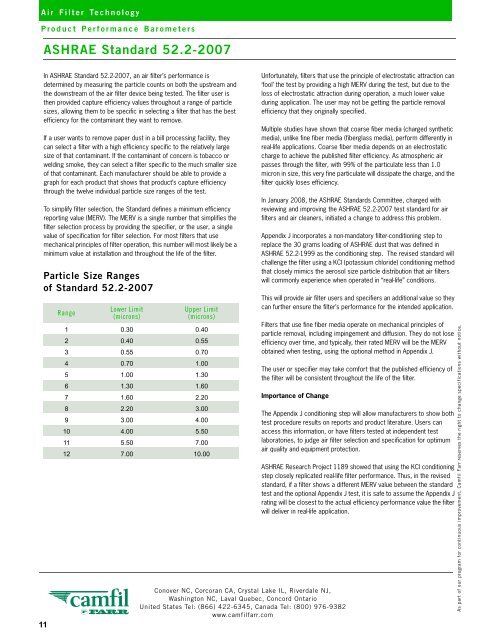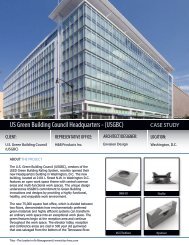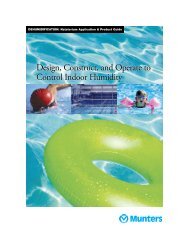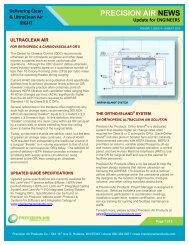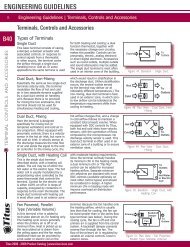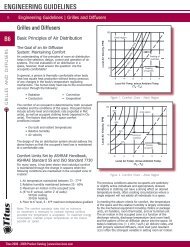Camfil Farr Product Catalog - Texas Air Products
Camfil Farr Product Catalog - Texas Air Products
Camfil Farr Product Catalog - Texas Air Products
Create successful ePaper yourself
Turn your PDF publications into a flip-book with our unique Google optimized e-Paper software.
<strong>Air</strong> Filter Technology<br />
<strong>Product</strong> Performance Barometers<br />
ASHRAE Standard 52.2-2007<br />
In ASHRAE Standard 52.2-2007, an air filter’s performance is<br />
determined by measuring the particle counts on both the upstream and<br />
the downstream of the air filter device being tested. The filter user is<br />
then provided capture efficiency values throughout a range of particle<br />
sizes, allowing them to be specific in selecting a filter that has the best<br />
efficiency for the contaminant they want to remove.<br />
If a user wants to remove paper dust in a bill processing facility, they<br />
can select a filter with a high efficiency specific to the relatively large<br />
size of that contaminant. If the contaminant of concern is tobacco or<br />
welding smoke, they can select a filter specific to the much smaller size<br />
of that contaminant. Each manufacturer should be able to provide a<br />
graph for each product that shows that product’s capture efficiency<br />
through the twelve individual particle size ranges of the test.<br />
To simplify filter selection, the Standard defines a minimum efficiency<br />
reporting value (MERV). The MERV is a single number that simplifies the<br />
filter selection process by providing the specifier, or the user, a single<br />
value of specification for filter selection. For most filters that use<br />
mechanical principles of filter operation, this number will most likely be a<br />
minimum value at installation and throughout the life of the filter.<br />
Particle Size Ranges<br />
of Standard 52.2-2007<br />
11<br />
Range<br />
Lower Limit<br />
(microns)<br />
Upper Limit<br />
(microns)<br />
1 0.30 0.40<br />
2 0.40 0.55<br />
3 0.55 0.70<br />
4 0.70 1.00<br />
5 1.00 1.30<br />
6 1.30 1.60<br />
7 1.60 2.20<br />
8 2.20 3.00<br />
9 3.00 4.00<br />
10 4.00 5.50<br />
11 5.50 7.00<br />
12 7.00 10.00<br />
Conover NC, Corcoran CA, Crystal Lake IL, Riverdale NJ,<br />
Washington NC, Laval Quebec, Concord Ontario<br />
United States Tel: (866) 422-6345, Canada Tel: (800) 976-9382<br />
www.camfilfarr.com<br />
Unfortunately, filters that use the principle of electrostatic attraction can<br />
‘fool’ the test by providing a high MERV during the test, but due to the<br />
loss of electrostatic attraction during operation, a much lower value<br />
during application. The user may not be getting the particle removal<br />
efficiency that they originally specified.<br />
Multiple studies have shown that coarse fiber media (charged synthetic<br />
media), unlike fine fiber media (fiberglass media), perform differently in<br />
real-life applications. Coarse fiber media depends on an electrostatic<br />
charge to achieve the published filter efficiency. As atmospheric air<br />
passes through the filter, with 99% of the particulate less than 1.0<br />
micron in size, this very fine particulate will dissipate the charge, and the<br />
filter quickly loses efficiency.<br />
In January 2008, the ASHRAE Standards Committee, charged with<br />
reviewing and improving the ASHRAE 52.2-2007 test standard for air<br />
filters and air cleaners, initiated a change to address this problem.<br />
Appendix J incorporates a non-mandatory filter-conditioning step to<br />
replace the 30 grams loading of ASHRAE dust that was defined in<br />
ASHRAE 52.2-1999 as the conditioning step. The revised standard will<br />
challenge the filter using a KCl (potassium chloride) conditioning method<br />
that closely mimics the aerosol size particle distribution that air filters<br />
will commonly experience when operated in “real-life” conditions.<br />
This will provide air filter users and specifiers an additional value so they<br />
can further ensure the filter’s performance for the intended application.<br />
Filters that use fine fiber media operate on mechanical principles of<br />
particle removal, including impingement and diffusion. They do not lose<br />
efficiency over time, and typically, their rated MERV will be the MERV<br />
obtained when testing, using the optional method in Appendix J.<br />
The user or specifier may take comfort that the published efficiency of<br />
the filter will be consistent throughout the life of the filter.<br />
Importance of Change<br />
The Appendix J conditioning step will allow manufacturers to show both<br />
test procedure results on reports and product literature. Users can<br />
access this information, or have filters tested at independent test<br />
laboratories, to judge air filter selection and specification for optimum<br />
air quality and equipment protection.<br />
ASHRAE Research Project 1189 showed that using the KCl conditioning<br />
step closely replicated real-life filter performance. Thus, in the revised<br />
standard, if a filter shows a different MERV value between the standard<br />
test and the optional Appendix J test, it is safe to assume the Appendix J<br />
rating will be closest to the actual efficiency performance value the filter<br />
will deliver in real-life application.<br />
As part of our program for continuous improvement, <strong>Camfil</strong> <strong>Farr</strong> reserves the right to change specifications without notice.


